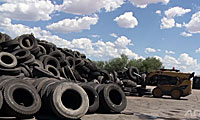How it's made: Rubberized asphalt
How it's made: Rubberized asphalt

If you’ve been reading this blog for a while, by now you should know plenty about rubberized asphalt. We’ve covered what it is, why it’s used and the many benefits it offers. However, we’ve never before explained how it gets made … until today.
The process is really fascinating and, as you can see in the video above, it all starts with tires – lots and lots of tires.
First they’re taken to a facility where much of the wire is pulled out. Next, they get shredded and sent off to a cryogenic system that freezes the rubber to -300 F. The cold temperature gives the rubber glass-like properties, allowing it to be smashed into millions of pieces. From there, the remaining steel and fiber components of the tires are removed…vacuums and magnets are utilized in this step.
After all that, the crumb rubber is blended into a liquid product to create rubberized asphalt. That mixture, also called a binder, gets dried and blended with oil before being applied to the road.
More about rubberized asphalt
Roughly 1,500 tires are used for every lane-mile of rubberized paving. To give you an idea of what that means, on just one 10-mile, six-lane highway ADOT covers 60 “lane miles.” Multiply that by 1,500 old tires and that equals 90,000 old tires that have been recycled and re-used.
While the environmental benefit is significant, there are several reasons why ADOT uses rubberized asphalt, including its noise-reducing properties and its ability to resist cracking.
“When we started using asphalt rubber and started using the crumb rubber from the tires, we didn’t do it so much to recycle tires,” says Assistant State Engineer for Construction Julie Kliewer in the video above. “The material is a better material because of it because it helps resist not only cold-weather cracking, but the normal cracking that happens from the fatigue or the aging of the roadway. The bonus is that we’re taking those tires out of the waste stream.”
For more information on rubberized, visit ADOT’s Quiet Pavement Web page or check out our previous blog posts and videos.
